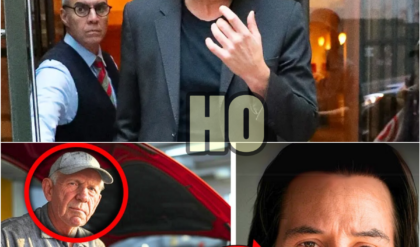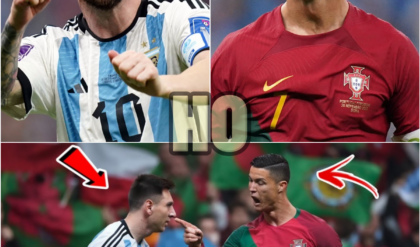The player who leads the Oklahoma City Thunder in fourth-quarter scoring is a devastatingly smooth operator — a dude capable of beating you by pulling from deep, getting downhill to make a play or slicing all the way to the rim for a DIY bucket.
He’s adept at lulling defenders to sleep with the pace of his dribble before bursting past them on the way to the basket; once in motion, he’s got the brakes to stop on a dime and enough brawn for a bump-off to create space for a quick-trigger pull-up. Add all that to a combination of polished footwork, go-go Gadget arms and a feathery touch, unlocking all manner of nifty finishes on the interior, and you’ve got a real three-level nightmare.
You know what’s nuts? The Thunder also have Shai Gilgeous-Alexander.
That’s right: The top final-frame scorer for the title-contending Thunder isn’t the bona fide MVP candidate who’s averaging more than 31 points per game. Nor is it Chet Holmgren, the tall drink of water whose pathway to Rookie of the Year honors has likely been blocked by that other, taller bottle of Evian, but who remains a walking mismatch with a pure pick-and-pop stroke and a face-up game from Hell.
Nope: It’s Jalen Williams. The three-star prep prospect who turned into a three-year starter at Santa Clara. The 12th overall pick in the 2022 NBA Draft who turned into the second-place finisher in Rookie of the Year voting. Now, he’s the No. 2 option on a Thunder squad with championship aspirations as real as the talent they’re putting on the court every night … and a player whose all-around game — equal parts silk and smash, just as comfortable cooking with the rock as he is working to shut off an opponent’s water — might just turn him into an even more luminous brand of star.
Consider:
Only nine players in the entire NBA have scored more points in the fourth this season than Williams. Four of them (Giannis Antetokounmpo, Stephen Curry, LeBron James, Kevin Durant) have won Most Valuable Player. Four of them (Trae Young, De’Aaron Fox, Luka Dončić, DeMar DeRozan) have made All-NBA. The other (Tyrese Maxey) just made his first All-Star team. And then, there’s J-Dub.
The 6-foot-5, 195-pound swingman has been at his best when the game’s close in the late stages, shooting a scorching 18-for-26 (69.2%) in “clutch” time — defined by NBA Advanced Stats as situations in which the score is within five points in the final five minutes of the fourth quarter or overtime. That’s the best clutch shooting percentage among players with at least 25 crunch-time attempts.
He’s averaging 19.1 points, 4.0 rebounds and 4.5 assists per game this season, shooting 54% from the field. Before this season, only five players age 22 or younger had ever averaged better than 19-4-4 while making more than half of their shots: Giannis, Kareem Abdul-Jabbar, Michael Jordan, David Thompson and Kevin Johnson. (On pace to join J-Dub in crashing that list this season? Precocious Rockets pivot Alperen Şengün.)
A handful of all-in-one advanced metrics — including estimated plus-minus, value over replacement player, win shares per 48 minutes, box plus-minus and player efficiency rating — peg Williams as somewhere between a top-30 and top-50 player in the league in just his second NBA season, which is the sort of trajectory that can land a young player in the company of All-Stars.
And speaking of trajectories: When you line Williams’ production to date up alongside several other high-end playmaking wings at that same point in their developments, Kostya Medvedovsky’s DARKO player performance projection system sees J-Dub impacting the score of the game at about the same level — maybe even a bit more — than those future stars did when they were his age:
DARKO career DPM Progression
The caveat: No matter how finely tuned the model, any projection is just that — an estimate, a forecast, one potential outcome plucked out of a field of countless possibilities. There’s no guarantee that Williams’ trend line will keep rising to mirror the likes of Gilgeous-Alexander, Jimmy Butler, Devin Booker and Bradley Beal; no guarantee he’ll become a multiple-time All-Star, All-NBA candidate or MVP hopeful.
What he’s put on tape and in the numbers over the past two years, though, suggests there’s at least a chance that he will. And that is an extremely exciting prospect for a franchise that knows a little bit about hitting multiple moonshot dingers in the draft.
(Bruno Rouby/Yahoo Sports Illustration)
“Special,” says no less a talent evaluator than eight-time All-Defensive selection Draymond Green, who got an up-close-and-personal look at Williams scoring 28 points on 15 shots when OKC beat the Warriors in overtime back in December. “Special. Dude can shoot, he can pass, he can handle, he can finish, he can defend. He has great size, so he can guard multiple positions. He’s athletic. He’s great in the pick-and-roll. Like … Jalen Williams is special. Over/under two years until he’s an All-Star himself. I’m going to take the under. He is a problem.”
The problems start — as so much does for the Thunder — off the dribble.
Oklahoma City’s offense, with all its inverted screening actions and guard-guard pick-and-rolls, is designed in part to spread opponents out to open up lanes for forays into the paint. It’s a system built to maximize the syncopated brilliance of Gilgeous-Alexander, the league’s premier driver; for the fourth straight season, both he and the Thunder as a whole lead the NBA in drives per game.
But as defenses throw more aggressive and varied coverages at the Thunder, head coach Mark Daigneault has sought different options to wrongfoot opponents locking in to try to slow down Gilgeous-Alexander.
“We don’t want to be a team that’s predictable,” Daigneault said.
Enter Williams, a walking off-speed pitch who can leverage all that space and all those opportunities to his advantage, too:
A point guard and primary playmaker at Santa Clara, Williams is comfortable moving at his own pace on the ball, using his handle to lull defenders to sleep before hitting the gas. Once he gains that first step, he’s got the frame to hold off trailing defenders, the handle to maneuver through tight spaces, the strength to go up through contact and enough bounce to get above the rim.
If onrushing helpers or menacing shot-blockers alter his flight plan, though, Williams can deploy his secret weapon: the 7-foot-2 wingspan that affords him access to more release angles on shots near the basket. Scoop layups, floaters, runners and half-hooks — Williams has them all in the bag … not unlike the dude with whom he’s been comparing notes these past two seasons.
“He wants to be great,” Gilgeous-Alexander recently told reporters. “So he makes it easy to help him.”
Thanks partly to that external help, and largely to the tools he’s bringing to the table, Williams ranks in the top 30 in the NBA in drives per game and points scored off drives in his own right, shooting 53.7% on his off-the-dribble excursions into the lane — and 69% inside the restricted area, a strong mark for a wing.
“My approach is, go with force, and keep going until someone stops you,” Williams recently told ESPN’s Chris Herring. “If someone stops you, then you go to Plan B.”
For Williams, Plan B often comes in the form of a pull-up jumper that marries brute force, balletic footwork and a deft touch. Cut off his driving angle, and one of the league’s smoothest shot-creators will lower the shoulder like a fullback looking to push the pile, dislodging his defender to create space. From there, it’s anybody’s guess whether he’ll stop cold to rise up, reverse-pivot into a pirouetting release or jump off his plant foot with a Dirk Nowitzki-style one-legged fadeaway that defenders have a miserable time contesting:
That kind of instinctive improvisation — whatever you throw at me, I’ve got a counter, and when you step to that, I’ve got a counter to the counter — is what led Daigneault to describe Williams earlier this season as an “artist,” as opposed to a “scientist.”
“A scientist is in the lab,” Daigneault explained. “And an artist is throwing paint against the canvas.”
Well, call him J-Dub Pollock, because Williams is shooting a scorching 56.6% on pull-up 2-pointers this season, according to NBA Advanced Stats, and just under 50% from midrange overall. The list of players who’ve both made more middies and shot them at a higher percentage than J-Dub is pretty damn short: Kevin Durant, Joel Embiid, Khris Middleton, Michael Porter Jr., Brandon Miller, Deandre Ayton and Tyrese Haliburton — the only other sub-6-foot-6 dude on the list.
The downhill attacking and stop-and-pop midrange game make Williams a brutally tough cover off the bounce. Combine that with the deep shooting development that’s seen him go from a 35.6% 3-point shooter as a rookie to a 44.3% marksman as a sophomore (the sixth-best mark in the NBA, with nearly equal accuracy shooting off the dribble or off the catch) and the steady-handed playmaking that can produce five assists per 36 minutes of floor time with a 2.7-to-1 assist-to-turnover ratio (a top-20 mark among high-usage players) and you’ve got … well, in Draymond’s words, a problem.
What helps make Williams such a huge part of Oklahoma City’s solution, though, is how neatly he fits into what Daigneault wants to accomplish on the other end of the floor, too. He’s a smart defender with good hands, posting solid block and steal rates for a wing and tying for 14th in the league in deflections per game. He’s quick enough to navigate screens and stick with ball-handlers, whether tracking them away from the ball or guarding in the two-man game and funneling them toward Holmgren in the paint.
A versatile defender, Williams is a star in the making on both ends. (Photo by Joshua Gateley/Getty Images)
Williams doesn’t have to take the most daunting perimeter challenge on a nightly basis — one of the benefits of playing on a top-six defense with a literal group chat’s worth of wing stoppers, led by ambulatory cinder block Luguentz Dort. He rarely gets off light, though, because he frequently plays power forward alongside Holmgren … which means he’s tasked with using his strength and length to battle much larger opponents. Like, say, his two most frequent defensive matchups this season: Victor Wembanyama and Karl-Anthony Towns.
“We’ve cross-matched him onto centers,” Daigneault told Anthony Slater of The Athletic. “We’ve had him guard Lauri Markkanen. He guarded Giannis [Antetokounmpo]. He’ll shift onto a point guard. We’ve had him switch onto Donovan Mitchell and Jamal Murray. It’s hard to explain how impactful that is for you. You have this piece that’s a 30-minute player who is a great offensive player that you’re also moving all over the lineup.”
Players who average 30-plus-minutes a night, can be great offensively in multiple different roles and can move all over the lineup and not only hold up but actually be a net positive for a high-end defense … there aren’t a whole lot of them, and there’s a word for them. As one of them, SGA knows it well.
“He’s gonna be a star in this league for a long time,” Gilgeous-Alexander told reporters in December, after Williams had poured in a career-high 36 points on 13-for-17 shooting to beat the Knicks. “As we can see, sky’s the limit for him.”

Just what that limit might be is an awfully interesting question. Context is everything in the NBA; as impressive as Williams’ box-score and advanced numbers look, they’ve largely come playing alongside a supernova shot creator. What might Williams’ production look like if he had the keys full-time?
We haven’t had many opportunities to see what that might look like. Williams’ numbers did spike last season during a post-All-Star-break period in which Gilgeous-Alexander missed seven of 10 games with abdominal and ankle injuries: 22.3 points, 4.9 rebounds, 5.5 assists and 2.1 steals in 33.2 minutes per game on .673 true shooting. And his production has soared with Gilgeous-Alexander off the floor this season, largely in stints at the start of second and fourth quarters, when SGA takes a breather and J-Dub gets to run the show: 34.6 points and 8.3 assists per 100 possessions with a 28.9% usage rate and a .613 true shooting percentage, according to PBP Stats.
On one hand, that’s eye-popping production — the kind of per-possession output that only MVPs and All-NBA selections have mustered over the course of a full season, and that maybe calls to mind the last time an extremely exciting Oklahoma City roster featured a dramatically overqualified third option. On the other, though, the context of the Thunder’s pitch-perfect rebuild looms large.
The Thunder appear to have a new Big Three. (AP Photo/Darren Abate)
Would Williams’ shot creation for himself and others play up as much outside of Daigneault’s funky five-out system, an ecosystem replete with plus shooters who can also put the ball on the deck and make the next pass? Would the weight of an increased workload mean a dramatic decrease in his scoring efficiency? Would more offensive responsibility mean a drop-off in the defensive work that’s made him such a crucial piece of OKC’s top-five unit? And even if a framework constructed around J-Dub meant a spike in his individual numbers, would it be one that could win at a high level? (Here’s where we note that, while J-Dub’s numbers leap off the page without SGA, the Thunder as a whole have been outscored in those minutes, with an offense that would place just above the bottom-10 in the league in points scored per possession.)
Whether or not Williams could be a high-end No. 1 option on his own team is irrelevant for right now. He doesn’t even become extension-eligible until the summer of 2025, meaning Thunder personnel chief Sam Presti’s got more than a year to collect information, line up his balance sheet and prepare for an alternate future where he keeps that overqualified third option this time. As he does so, he’ll watch the team he built — the NBA’s second-youngest, on average, and its third-best, in terms of net rating — work to deconstruct the canard that youth isn’t served in the postseason.
If it does — if this iteration of the Thunder is able to succeed where its MVP-laden predecessor fell just sort — it’ll be because Gilgeous-Alexander turned into the brightest possible jewel of the Paul George trade, and because Holmgren was ready to be everything anyone hoped he might be the second he got healthy enough to set foot on the floor, and because Daigneault pulled every right lever to get the most out of his delightful oddball roster. But it’ll also be because, with the 12th pick in the draft, Presti plucked the kind of difference-maker who can turn a nice story into a nightmare — the kind of guy who can convince even a top-tier MVP candidate to decide to just toss him the ball, set him a screen and let him cook.
“Our team is in the right spot,” Williams said after Oklahoma City’s Sunday win over the Suns. “We all trust each other; that’s our biggest thing. Everybody is ready to be the next man up.”
Williams, maybe, more than most.
News
Test đẩy bài từ cms
Test đẩy bài từ cms, xóa sau khi dùng.
BREAKING: NFL Unanimously Votes In New Controversial Rule
(Photo by Ethan Miller/Getty Images) The NFL seems to be destined to ban the hip-drop tackle this week. The league office wants to ban a certain type of hip-drop tackle. The NFLPA disagrees. The owners voted on it. On Monday, it was…
Everyone Noticed The Same Strange Thing About This Year’s NFL Coaches Photo
Fans had questions after five NFL head coaches missed out on the league’s annual photo this week. Most of the coaches are in Orlando, Florida at the moment as the NFL annual owners meeting is taking place there. So they came together…
5 Most Overrated NFL Free Agent Signings Of 2024 So Far…And 5 Most Underrated That Are Flying Under The Radar
Now that most of the top 2024 NFL free agents are off the board, it’s a good time to look at which highly-anticipated signings are bound to disappoint — and which under-the-radar moves will pay more dividends than you think. So with…
Ranking The Craziest NFL Free Agent Deals Of All-Time From WORST To FIRST
Free agency completely changes the landscape of professional sports. When a player’s contract is up—he can go to any team and drastically alter the balance of power in the league. The NFL is no different. All it takes is one crazy deal…
BREAKING: AFC Super Bowl Contender Has Officially Made A Contract Offer To Odell Beckham Jr.
The Miami Dolphins have some interest in veteran playmaker, Odell Beckham Jr. Miami Dolphins coach Mike McDaniel spoke to reporters about the team’s early offseason at the NFL annual meeting Monday at the Ritz-Carlton Grande Lakes and informed everyone that the Dolphins and Odell Beckham Jr….
End of content
No more pages to load











 VICTORIA JUDICIAL de Ortega Cano y Gloria Camila a Kiko Jiménez y Sofía Suescun por Telecinco | HO
VICTORIA JUDICIAL de Ortega Cano y Gloria Camila a Kiko Jiménez y Sofía Suescun por Telecinco | HO